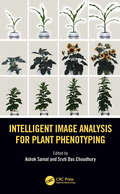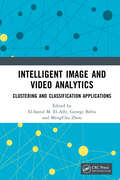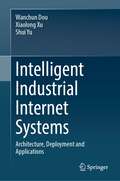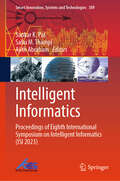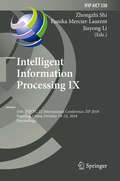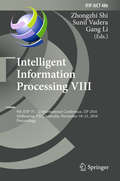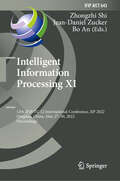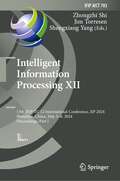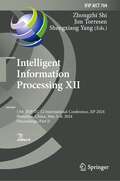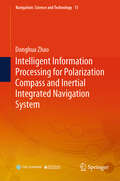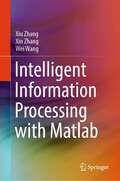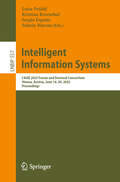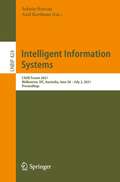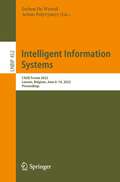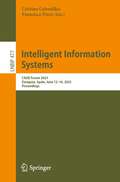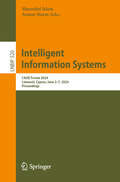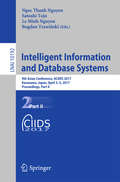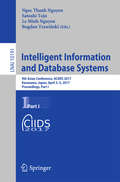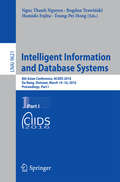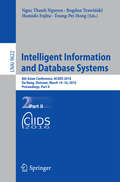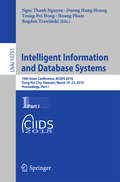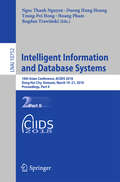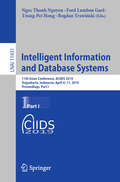- Table View
- List View
Intelligent Image Analysis for Plant Phenotyping
by Ashok Samal and Sruti Das ChoudhuryDomesticated crops are the result of artificial selection for particular phenotypes or, in some cases, natural selection for an adaptive trait. Plant traits can be identified through image-based plant phenotyping, a process that was, until recently, strenous and time-consuming. Intelligent Image Analysis for Plant Phenotyping reviews information on time-saving techniques, using computer vision and imaging technologies. These methodologies provide an automated, non-invasive, and scalable mechanism by which to define and collect plant phenotypes. Beautifully illustrated, with numerous color images, the book focuses on phenotypes measured from individual plants under controlled experimental conditions, which are widely available in high-throughput systems. Features: Presents methodologies for image processing, including data-driven and machine learning techniques for plant phenotyping. Features information on advanced techniques for extracting phenotypes through images and image sequences captured in a variety of modalities. Includes real-world scientific problems, including predicting yield by modeling interactions between plant data and environmental information. Discusses the challenge of translating images into biologically informative quantitative phenotypes. A practical resource for students, researchers, and practitioners, this book is invaluable for those working in the emerging fields at the intersection of computer vision and plant sciences.
Intelligent Image and Video Analytics
by George Bebis MengChu Zhou El-Alfy, El-Sayed M.Video has rich information including meta-data, visual, audio, spatial and temporal data which can be analysed to extract a variety of low and high-level features to build predictive computational models using machine-learning algorithms to discover interesting patterns, concepts, relations, and associations. This book includes a review of essential topics and discussion of emerging methods and potential applications of video data mining and analytics. It integrates areas like intelligent systems, data mining and knowledge discovery, big data analytics, machine learning, neural network, and deep learning with focus on multimodality video analytics and recent advances in research/applications. Features: Provides up-to-date coverage of the state-of-the-art techniques in intelligent video analytics. Explores important applications that require techniques from both artificial intelligence and computer vision. Describes multimodality video analytics for different applications. Examines issues related to multimodality data fusion and highlights research challenges. Integrates various techniques from video processing, data mining and machine learning which has many emerging indoors and outdoors applications of smart cameras in smart environments, smart homes, and smart cities. This book aims at researchers, professionals and graduate students in image processing, video analytics, computer science and engineering, signal processing, machine learning, and electrical engineering.
Intelligent Industrial Internet Systems: Architecture, Deployment and Applications
by Shui Yu Xiaolong Xu Wanchun DouIn the process of transforming modern manufacturing into intelligent manufacturing, more and more manufacturing processes are being deployed digitally on the Internet. As a novel digital industrial infrastructure and new application ecology, Industrial Internet could integrate the novel information and communication technology into various industrial manufacturing processes, through the safe and reliable intelligent interconnection of factors concerning people, machines and things. It aims at significantly improving the digitalization, networking and intelligence of manufacturing processes through the comprehensive interconnection of all manufacturing factors. To deploy and run traditional manufacturing processes on Industrial Internet efficiently, corresponding digital technical means are called for. These technical means play an important role in many potential applications of intelligent manufacturing, e.g. integrating product lifecycle data, strengthening industrial chain cooperation, providing decision-making service information oriented on the production organization process, and providing data support for product optimization and upgrading.This book focuses on the theory, techniques and means for integrating intelligent Industrial Internet applications deployed via mobile edge computing. Concretely, it mainly studies the intelligent theory, techniques and means from a problem-driven and demand-driven perspective, which supports collaborative design, agile manufacturing, remote operation and maintenance on Industrial Internet. These technologies primarily include Industrial Internet-centric intelligent resource scheduling methods, various types of industrial data privacy protection, intelligent version management technologies supporting digital twin applications, various data mining algorithms for intelligent execution of business processes, etc. Given its scope, the book offers a valuable theoretical and technical resource for project managers, technical developers, researchers, educators and students at colleges and universities.
Intelligent Informatics: Proceedings of Eighth International Symposium on Intelligent Informatics (ISI 2023) (Smart Innovation, Systems and Technologies #389)
by Ajith Abraham Sankar K. Pal Sabu M. ThampiThis book constitutes thoroughly refereed post-conference proceedings of the 8th International Symposium on Intelligent Informatics (ISI 2023), December 18–20, 2023, Bangalore, India. The revised papers presented were carefully reviewed and selected from several initial submissions. The scope of the symposium includes AI, machine learning, cognitive computing, soft computing, security informatics, data science, computer vision, pattern recognition, intelligent software engineering, intelligent networked systems, IoT, cyber-physical systems, and NLP. The book is directed to the researchers and scientists engaged in various fields of computing and network communication domains.
Intelligent Information Processing IX: 10th IFIP TC 12 International Conference, IIP 2018, Nanning, China, October 19-22, 2018, Proceedings (IFIP Advances in Information and Communication Technology #538)
by Eunika Mercier-Laurent Jiuyong Li Zhongzhi ShiThis book constitutes the refereed proceedings of the 10th IFIP TC 12 International Conference on Intelligent Information Processing, IIP 2018, held in Nanning, China, in October 2018. The 37 full papers and 8 short papers presented were carefully reviewed and selected from 80 submissions. They are organized in topical sections on machine learning, deep learning, multi-agent systems, neural computing and swarm intelligence, natural language processing, recommendation systems, social computing, business intelligence and security, pattern recognition, and image understanding.
Intelligent Information Processing VIII
by Gang Li Sunil Vadera Zhongzhi ShiThis book constitutes the refereed proceedings of the 9th IFIP TC 12 International Conference on Intelligent Information Processing, IIP 2016, held in Melbourne, VIC, Australia, in October 2016. The 24 full papers and 3 short papers presented were carefully reviewed and selected from more than 40 submissions. They are organized in topical sections on machine learning, data mining, deep learning, social computing, semantic web and text processing, image understanding, and brain-machine collaboration.
Intelligent Information Processing VIII: 9th IFIP TC 12 International Conference, IIP 2016, Melbourne, VIC, Australia, November 18-21, 2016, Proceedings (IFIP Advances in Information and Communication Technology #486)
by Zhongzhi Shi, Sunil Vadera and Gang LiThis book constitutes the refereed proceedings of the 9th IFIP TC 12 International Conference on Intelligent Information Processing, IIP 2016, held in Melbourne, VIC, Australia, in October 2016. The 24 full papers and 3 short papers presented were carefully reviewed and selected from more than 40 submissions. They are organized in topical sections on machine learning, data mining, deep learning, social computing, semantic web and text processing, image understanding, and brain-machine collaboration.
Intelligent Information Processing X: 11th IFIP TC 12 International Conference, IIP 2020, Hangzhou, China, July 3–6, 2020, Proceedings (IFIP Advances in Information and Communication Technology #581)
by Sunil Vadera Zhongzhi Shi Elizabeth ChangThis book constitutes the refereed proceedings of the 11th IFIP TC 12 International Conference on Intelligent Information Processing, IIP 2020, held in Hangzhou, China, in July 2020. The 24 full papers and 5 short papers presented were carefully reviewed and selected from 36 submissions. They are organized in topical sections on machine learning; multi-agent system; recommendation system; social computing; brain computer integration; pattern recognition; and computer vision and image understanding.
Intelligent Information Processing XI: 12th IFIP TC 12 International Conference, IIP 2022, Qingdao, China, May 27–30, 2022, Proceedings (IFIP Advances in Information and Communication Technology #643)
by Bo An Jean-Daniel Zucker Zhongzhi ShiThis book constitutes the refereed proceedings of the 12th IFIP TC 12 International Conference on Intelligent Information Processing, IIP 2022, held in Qingdao, China, in July 2022. The 37 full papers and 6 short papers presented were carefully reviewed and selected from 57 submissions. They are organized in topical sections on Machine Learning, Data Mining, Multiagent Systems, Social Computing, Blockchain Technology, Game Theory and Emotion, Pattern Recognition, Image Processing and Applications.
Intelligent Information Processing XII: 13th IFIP TC 12 International Conference, IIP 2024, Shenzhen, China, May 3–6, 2024, Proceedings, Part I (IFIP Advances in Information and Communication Technology #703)
by Zhongzhi Shi Shengxiang Yang Jim TorresenThe two-volume set IFIP AICT 703 and 704 constitutes the refereed conference proceedings of the 13th IFIP TC 12 International Conference on Intelligent Information Processing XII, IIP 2024, held in Shenzhen, China, during May 3–6, 2024. The 49 full papers and 5 short papers presented in these proceedings were carefully reviewed and selected from 58 submissions. The papers are organized in the following topical sections: Volume I: Machine Learning; Natural Language Processing; Neural and Evolutionary Computing; Recommendation and Social Computing; Business Intelligence and Risk Control; and Pattern Recognition. Volume II: Image Understanding.
Intelligent Information Processing XII: 13th IFIP TC 12 International Conference, IIP 2024, Shenzhen, China, May 3–6, 2024, Proceedings, Part II (IFIP Advances in Information and Communication Technology #704)
by Zhongzhi Shi Shengxiang Yang Jim TorresenThe two-volume set IFIP AICT 703 and 704 constitutes the refereed conference proceedings of the 13th IFIP TC 12 International Conference on Intelligent Information Processing XII, IIP 2024, held in Shenzhen, China, during May 3–6, 2024. The 49 full papers and 5 short papers presented in these proceedings were carefully reviewed and selected from 58 submissions. The papers are organized in the following topical sections: Volume I: Machine Learning; Natural Language Processing; Neural and Evolutionary Computing; Recommendation and Social Computing; Business Intelligence and Risk Control; and Pattern Recognition.Volume II: Image Understanding.
Intelligent Information Processing for Polarization Compass and Inertial Integrated Navigation System (Navigation: Science and Technology #15)
by Donghua ZhaoThis book systematically elaborates on the intelligent information processing technology for a bioinspired polarization compass and inertial integrated navigation system. It consists of three parts. Firstly, the research background and significance of intelligent information processing technology for a bioinspired polarization compass are introduced. It analyzes the research status, development trends, and comparisons with foreign countries in the field of orientation methods based on atmospheric polarization patterns. The processing methods of the orientation error for a bioinspired polarization compass and integrated system information processing are also covered. Subsequently, the noise components of a bioinspired polarization compass and the impact of noise on its directional accuracy are discussed. It also introduces the denoising and orientation error compensation technique based on intelligent algorithms such as multi-scale principal component analysis and multi-scale adaptive time-frequency peak filtering. The third part focuses on the application of cubature Kalman filter and their improvement methods in seamless combination orientation systems based on a bioinspired polarization compass. A seamless combination orientation model under discontinuous observation conditions is proposed and a discontinuous observation algorithm based on neural networks is designed.
Intelligent Information Processing with Matlab
by Xin Zhang Wei Wang Xiu ZhangThis book is a comprehensive collection of technologies and methods on intelligent information processing, which includes artificial neural network, fuzzy logic, and evolutionary computing. It also introduces the latest research directions and progress in intelligent information processing, such as transfer learning through convolutional neural network, time series prediction, clustering based on fuzzy neural network, test and evaluation of the traveling salesman problem, test and evaluation of continuous optimization problem, and more. This book promotes the development and application of intelligent information processing technology in the field of computational intelligence, effectively improving the intersection and integration of intelligent information processing methods. Researchers in computational intelligence and artificial intelligence technology, as well as teachers, students, and others interested in the subject, will benefit from this book.
Intelligent Information Systems: CAiSE 2025 Forum and Doctoral Consortium, Vienna, Austria, June 16-20, 2025, Proceedings (Lecture Notes in Business Information Processing #557)
by Selmin Nurcan Sergio España Luise Pufahl Kristina RosenthalThis book constitutes the thoroughly refereed proceedings of the CAiSE 2025 Forum and Doctoral Consortium, held as part of the 37th International Conference on Advanced Information Systems Engineering, CAiSE 2025, during June 2025. This year the conference took place under the theme "Bridging Silos". The CAiSE Forum is a place for presenting and discussing new ideas and tools related to information systems engineering. Intended to serve as an interactive platform, the Forum aims at the presentation of emerging new topics and controversial positions, as well as demonstration of innovative systems, tools and applications. It received 23 submissions of which 11 have been accepted; 15 submissions were invited from the CAISE main research track. The overall 26 papers include 20 vision and 6 tool demonstration papers. The Doctoral Consortium aims to attract PhD candidates working on foundations, techniques, tools, and applications in the Information Systems Engineering field. The Doctoral Consortium received a total of 27 submissions of which 12 were accepted for presentation.
Intelligent Information Systems: CAiSE Forum 2021, Melbourne, VIC, Australia, June 28 – July 2, 2021, Proceedings (Lecture Notes in Business Information Processing #424)
by Selmin Nurcan Axel KorthausThis book constitutes the thoroughly refereed proceedings of the CAiSE Forum 2021 which was held as part of the 33rd International Conference on Advanced Information Systems Engineering, CAiSE 2021, in June 2021. The conference was held virtually due to the COVID-19 pandemic.The CAiSE Forum is a place within the CAiSE conference for presenting and discussing new ideas and tools related to information systems engineering. Intended to serve as an interactive platform, the Forum aims at the presentation of emerging new topics and controversial positions, as well as demonstration of innovative systems, tools and applications. This year’s theme was “Intelligent Information Systems”.The 18 full papers presented in this volume were carefully reviewed and selected for inclusion in this book.
Intelligent Information Systems: CAiSE Forum 2022, Leuven, Belgium, June 6–10, 2022, Proceedings (Lecture Notes in Business Information Processing #452)
by Artem Polyvyanyy Jochen De WeerdtThis book constitutes the thoroughly refereed proceedings of the CAiSE Forum 2022 which was held in Leuven, Belgium, in June 2022, as part of the 34th International Conference on Advanced Information Systems Engineering, CAiSE 2022. The CAiSE Forum is a place within the CAiSE conference for presenting and discussing new ideas and tools related to information systems engineering. Intended to serve as an interactive platform, the Forum aims at the presentation of emerging new topics and controversial positions, as well as demonstration of innovative systems, tools and applications. The 15 full papers presented in this volume were carefully reviewed and selected from 24 submissions.
Intelligent Information Systems: CAiSE Forum 2023, Zaragoza, Spain, June 12–16, 2023, Proceedings (Lecture Notes in Business Information Processing #477)
by Cristina Cabanillas Francisca PérezThis book constitutes the thoroughly refereed proceedings of the CAiSE Forum 2023 which was held in Zaragoza, Spain, in June 2023, as part of the 35th International Conference on Advanced Information Systems Engineering, CAiSE 2023. The CAiSE Forum is a place within the CAiSE conference for presenting and discussing new ideas and tools related to information systems engineering. Intended to serve as an interactive platform, the Forum aims at the presentation of emerging new topics and controversial positions, as well as demonstration of innovative systems, tools and applications. This year’s edition of the conference put a special emphasis on the theme of Cyber-Human Systems. A total of 25 papers was sent for peer review. 12 of these papers were invited from CAiSE and 13 have been directly submitted to the Forum. After a careful review and selection, 12 of the invited and 6 of the newly submitted papers have been accepted for publication.
Intelligent Information Systems: CAiSE Forum 2024, Limassol, Cyprus, June 3–7, 2024, Proceedings (Lecture Notes in Business Information Processing #520)
by Arnon Sturm Shareeful IslamThis book constitutes the thoroughly refereed proceedings of the CAiSE Forum 2024 which was held in Limassol, Cyprus, in June 2024, as part of the 36th International Conference on Advanced Information Systems Engineering, CAiSE 2024. The CAiSE Forum is a place within the CAiSE conference for presenting and discussing new ideas and tools related to information systems engineering. Intended to serve as an interactive platform, the Forum aims at the presentation of emerging new topics and controversial positions, as well as demonstration of innovative systems, tools and applications. This year a special emphasis was given on Information Systems in the Age of Artificial Intelligence. The Forum received 31 submissions; 8 submissions were invited from the CAISE main research track. Out of the 23 regular submissions, 11 papers have been accepted. The 18 papers included in these proceedings include 10 vision papers and 8 tool demonstration papers.
Intelligent Information and Database Systems
by Ngoc Thanh Nguyen Bogdan Trawiński Satoshi Tojo Le Minh NguyenIntelligent information and database systems are two closely related and we- established subfields of modern computer science. They focus on the integration of artificial intelligence and classic database technologies in order to create the class of next generation information systems. The major target of this new gene- tion of systems is to provide end-users with intelligent behavior: simple and/or advanced learning, problem solving, uncertain and certain reasoning, se- organization, cooperation, etc. Such intelligent abilities are implemented in classic information systems to make them autonomous and user oriented, in particular when advanced problems of multimedia information and knowledge discovery, access, retrieval and manipulation are to be solved in the context of large, distr- uted and heterogeneous environments. It means that intelligent knowledge-based information and database systems are used to solve basic problems of large coll- tions management, carry out knowledge discovery from large data collections, reason about information under uncertain conditions, support users in their for- lation of complex queries etc. Topics discussed in this volume include but are not limited to the foundations and principles of data, information, and knowledge models, methodologies for intelligent information and database systems analysis, design, implementation, validation, maintenance and evolution.
Intelligent Information and Database Systems
by Ngoc Thanh Nguyen Bogdan Trawiński Satoshi Tojo Le Minh NguyenIntelligent information and database systems are two closely related and we- established subfields of modern computer science. They focus on the integration of artificial intelligence and classic database technologies in order to create the class of next generation information systems. The major target of this new gene- tion of systems is to provide end-users with intelligent behavior: simple and/or advanced learning, problem solving, uncertain and certain reasoning, se- organization, cooperation, etc. Such intelligent abilities are implemented in classic information systems to make them autonomous and user oriented, in particular when advanced problems of multimedia information and knowledge discovery, access, retrieval and manipulation are to be solved in the context of large, distr- uted and heterogeneous environments. It means that intelligent knowledge-based information and database systems are used to solve basic problems of large coll- tions management, carry out knowledge discovery from large data collections, reason about information under uncertain conditions, support users in their for- lation of complex queries etc. Topics discussed in this volume include but are not limited to the foundations and principles of data, information, and knowledge models, methodologies for intelligent information and database systems analysis, design, implementation, validation, maintenance and evolution.
Intelligent Information and Database Systems
by Tzung-Pei Hong Ngoc Thanh Nguyen Hamido Fujita Bogdan TrawińskiIntelligent information and database systems are two closely related and we- established subfields of modern computer science. They focus on the integration of artificial intelligence and classic database technologies in order to create the class of next generation information systems. The major target of this new gene- tion of systems is to provide end-users with intelligent behavior: simple and/or advanced learning, problem solving, uncertain and certain reasoning, se- organization, cooperation, etc. Such intelligent abilities are implemented in classic information systems to make them autonomous and user oriented, in particular when advanced problems of multimedia information and knowledge discovery, access, retrieval and manipulation are to be solved in the context of large, distr- uted and heterogeneous environments. It means that intelligent knowledge-based information and database systems are used to solve basic problems of large coll- tions management, carry out knowledge discovery from large data collections, reason about information under uncertain conditions, support users in their for- lation of complex queries etc. Topics discussed in this volume include but are not limited to the foundations and principles of data, information, and knowledge models, methodologies for intelligent information and database systems analysis, design, implementation, validation, maintenance and evolution.
Intelligent Information and Database Systems
by Tzung-Pei Hong Ngoc Thanh Nguyen Hamido Fujita Bogdan TrawińskiIntelligent information and database systems are two closely related and we- established subfields of modern computer science. They focus on the integration of artificial intelligence and classic database technologies in order to create the class of next generation information systems. The major target of this new gene- tion of systems is to provide end-users with intelligent behavior: simple and/or advanced learning, problem solving, uncertain and certain reasoning, se- organization, cooperation, etc. Such intelligent abilities are implemented in classic information systems to make them autonomous and user oriented, in particular when advanced problems of multimedia information and knowledge discovery, access, retrieval and manipulation are to be solved in the context of large, distr- uted and heterogeneous environments. It means that intelligent knowledge-based information and database systems are used to solve basic problems of large coll- tions management, carry out knowledge discovery from large data collections, reason about information under uncertain conditions, support users in their for- lation of complex queries etc. Topics discussed in this volume include but are not limited to the foundations and principles of data, information, and knowledge models, methodologies for intelligent information and database systems analysis, design, implementation, validation, maintenance and evolution.
Intelligent Information and Database Systems: 10th Asian Conference, ACIIDS 2018, Dong Hoi City, Vietnam, March 19-21, 2018, Proceedings, Part I (Lecture Notes in Computer Science #10751)
by Hoang Pham Tzung-Pei Hong Ngoc Thanh Nguyen Bogdan Trawiński Duong Hung HoangThe two-volume set LNAI 10751 and 10752 constitutes the refereed proceedings of the 10th Asian Conference on Intelligent Information and Database Systems, ACIIDS 2018, held in Dong Hoi City, Vietnam, in March 2018. The total of 133 full papers accepted for publication in these proceedings was carefully reviewed and selected from 423 submissions. They were organized in topical sections named: Knowledge Engineering and Semantic Web; Social Networks and Recommender Systems; Text Processing and Information Retrieval; Machine Learning and Data Mining; Decision Support and Control Systems; Computer Vision Techniques; Advanced Data Mining Techniques and Applications; Multiple Model Approach to Machine Learning; Sensor Networks and Internet of Things; Intelligent Information Systems; Data Structures Modeling for Knowledge Representation; Modeling, Storing, and Querying of Graph Data; Data Science and Computational Intelligence; Design Thinking Based R&D, Development Technique, and Project Based Learning; Intelligent and Contextual Systems; Intelligent Systems and Algorithms in Information Sciences; Intelligent Applications of Internet of Thing and Data Analysis Technologies; Intelligent Systems and Methods in Biomedicine; Intelligent Biomarkers of Neurodegenerative Processes in Brain; Analysis of Image, Video and Motion Data in Life Sciences; Computational Imaging and Vision; Computer Vision and Robotics; Intelligent Computer Vision Systems and Applications; Intelligent Systems for Optimization of Logistics and Industrial Applications.
Intelligent Information and Database Systems: 10th Asian Conference, ACIIDS 2018, Dong Hoi City, Vietnam, March 19-21, 2018, Proceedings, Part II (Lecture Notes in Computer Science #10752)
by Hoang Pham Tzung-Pei Hong Ngoc Thanh Nguyen Bogdan Trawiński Duong Hung HoangThe two-volume set LNAI 10751 and 10752 constitutes the refereed proceedings of the 10th Asian Conference on Intelligent Information and Database Systems, ACIIDS 2018, held in Dong Hoi City, Vietnam, in March 2018. The total of 133 full papers accepted for publication in these proceedings was carefully reviewed and selected from 423 submissions. They were organized in topical sections named: Knowledge Engineering and Semantic Web; Social Networks and Recommender Systems; Text Processing and Information Retrieval; Machine Learning and Data Mining; Decision Support and Control Systems; Computer Vision Techniques; Advanced Data Mining Techniques and Applications; Multiple Model Approach to Machine Learning; Sensor Networks and Internet of Things; Intelligent Information Systems; Data Structures Modeling for Knowledge Representation; Modeling, Storing, and Querying of Graph Data; Data Science and Computational Intelligence; Design Thinking Based R&D, Development Technique, and Project Based Learning; Intelligent and Contextual Systems; Intelligent Systems and Algorithms in Information Sciences; Intelligent Applications of Internet of Thing and Data Analysis Technologies; Intelligent Systems and Methods in Biomedicine; Intelligent Biomarkers of Neurodegenerative Processes in Brain; Analysis of Image, Video and Motion Data in Life Sciences; Computational Imaging and Vision; Computer Vision and Robotics; Intelligent Computer Vision Systems and Applications; Intelligent Systems for Optimization of Logistics and Industrial Applications.
Intelligent Information and Database Systems: 11th Asian Conference, ACIIDS 2019, Yogyakarta, Indonesia, April 8–11, 2019, Proceedings, Part I (Lecture Notes in Computer Science #11431)
by Tzung-Pei Hong Ngoc Thanh Nguyen Ford Lumban Gaol Bogdan TrawińskiThe two-volume set LNAI 11431 and 11432 constitutes the refereed proceedings of the 11th Asian Conference on Intelligent Information and Database Systems, ACIIDS 2019, held in Yogyakarta, Indonesia, in April 2019.The total of 124 full papers accepted for publication in these proceedings were carefully reviewed and selected from 309 submissions. The papers of the first volume are organized in the following topical sections: knowledge engineering and semantic web; text processing and information retrieval; machine learning and data mining; decision support and control systems; computer vision techniques; and databases and intelligent information systems. The papers of the second volume are divided into these topical sections: collective intelligence for service innovation, technology management, E-learning, and fuzzy intelligent systems; data structures modelling for knowledge representation; advanced data mining techniques and applications; intelligent information systems; intelligent methods and artificial intelligence for biomedical decision support systems; intelligent and contextual systems; intelligent systems and algorithms in information sciences; intelligent supply chains and e-commerce; sensor networks and Internet of Things; analysis of image, video, movements and brain intelligence in life sciences; and computer vision and intelligent systems.
